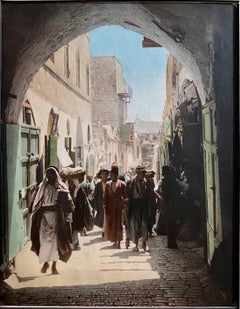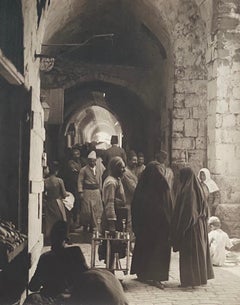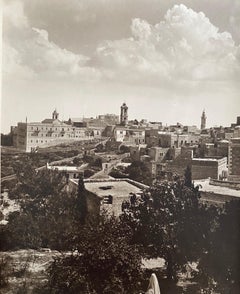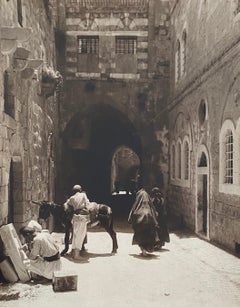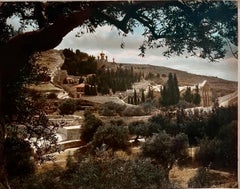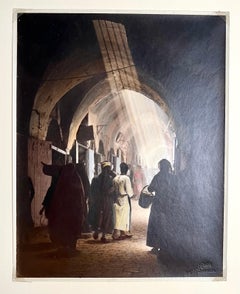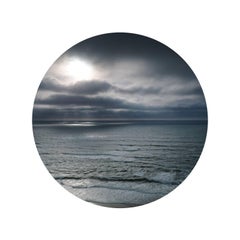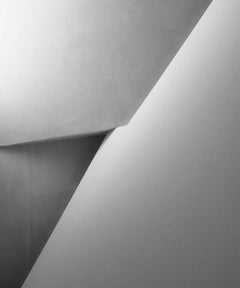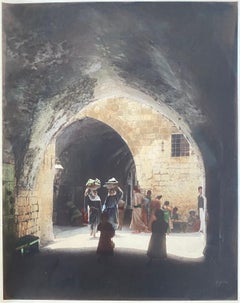American Colony Jerusalem Art
to
3
4
Overall Width
to
Overall Height
to
3
4
7
3
3
2
2
1
1
1
1
1
1
1
1
1
1
1
1
1
1
7
7
7
7,820
5,167
2,504
1,501
7
Artist: American Colony Jerusalem
Vintage Large Albumen Photo Jerusalem Photograph American Colony Old City Market
By American Colony Jerusalem
Located in Surfside, FL
The mat measures 21 X 16 the images are around 12 X 9 inches. They bear the blindstamp of the American Colony Jerusalem.
I am not sure if these are hand colored but they are from the period. Old City Shuk or Souq.
The Original American Colony was a colony established in Jerusalem in 1881 by members of a utopian society led by Anna and Horatio Spafford. Now a hotel in East Jerusalem, it is still known by that name today.
After suffering a series tragic losses following the Great Chicago Fire of 1871 (see hymn "It is Well with My Soul"), Chicago residents Anna and Horatio Spafford led a small American contingent in 1881 to Jerusalem to form a utopian society. The "American Colony," as it became known, was later joined by Swedish Christians. The society engaged in philanthropic work amongst the people of Jerusalem regardless of religious affiliation, gaining the trust of the local Muslim, Jewish, and Christian communities.During and immediately after World War I, the American Colony carried out philanthropic work to alleviate the suffering of the local inhabitants, opening soup kitchens, hospitals, orphanages and other charitable ventures.
Towards the end of the 1950s, the society's communal residence was converted into the American Colony Hotel. The hotel is an integral part of the Jerusalem landscape where members of all communities in Jerusalem still meet. In 1992 representatives from the Palestine Liberation Organization and Israel met in the hotel where they began talks that led to the historic 1993 Oslo Peace Accord.
Panorama of Jerusalem, c. 1890-1920
The Colony moved to the large house of a wealthy Arab landowner, Rabbah Husseini, outside the city walls in Sheikh Jarrah on the road to Nablus. Part of the building was used as a hostel for visitors from Europe and America. A small farm developed with animals, a butchery, a dairy, a bakery, a carpenter's shop, and a smithy. The economy was supplemented by a shop selling photographs, craft items and archaeological artifacts. The American Colonists were embraced by the Jewish and Palestinian communities for their good works, among them, teaching in both Muslim and Jewish schools.
Photography
Around 1900, Elijah Meyers, a member of the American Colony, began taking photographs of places and events in and around the city of Jerusalem. Meyers's work eventually expanded into a full-fledged photographic division within the Colony, including Hol Lars (Lewis) Larsson and G. Eric Matson, who later renamed the effort as the Matson Photographic Service. Their interest in archeological artifacts (such as the Lion Tower in Tripoli pictured here), and the detail of their photographs, led to widespread interest in their work by archeologists. The collection was later donated to the Library of Congress.
World War I
When the Ottoman Empire entered World War I as an ally of Germany in November 1914, Jerusalem and Palestine became a battleground between the Allied and the Central powers. The Allied forces from Egypt, under the leadership of the British, engaged the German, Austrian and Turkish forces in fierce battles for control of Palestine. During this time the American Colony assumed a more crucial role in supporting the local populace through the deprivations and hardships of the war. Because the Turkish military...
Category
Early 20th Century Academic American Colony Jerusalem Art
Materials
Photographic Paper
Vintage Large Albumen Photo - Via Dolorosa In Station Of The Bross. Jerusalem
By American Colony Jerusalem
Located in Surfside, FL
The Original American Colony was a colony established in Jerusalem in 1881 by members of a utopian society led by Anna and Horatio Spafford. Now a hotel in East Jerusalem, it is still known by that name today.
After suffering a series tragic losses following the Great Chicago Fire of 1871 (see hymn "It is Well with My Soul"), Chicago residents Anna and Horatio Spafford led a small American contingent in 1881 to Jerusalem to form a utopian society. The "American Colony," as it became known, was later joined by Swedish Christians. The society engaged in philanthropic work amongst the people of Jerusalem regardless of religious affiliation, gaining the trust of the local Muslim, Jewish, and Christian communities.During and immediately after World War I, the American Colony carried out philanthropic work to alleviate the suffering of the local inhabitants, opening soup kitchens, hospitals, orphanages and other charitable ventures.
Towards the end of the 1950s, the society's communal residence was converted into the American Colony Hotel. The hotel is an integral part of the Jerusalem landscape where members of all communities in Jerusalem still meet. In 1992 representatives from the Palestine Liberation Organization and Israel met in the hotel where they began talks that led to the historic 1993 Oslo Peace Accord.
Panorama of Jerusalem, c. 1890-1920
The Colony moved to the large house of a wealthy Arab landowner, Rabbah Husseini, outside the city walls in Sheikh Jarrah on the road to Nablus. Part of the building was used as a hostel for visitors from Europe and America. A small farm developed with animals, a butchery, a dairy, a bakery, a carpenter's shop, and a smithy. The economy was supplemented by a shop selling photographs, craft items and archaeological artifacts. The American Colonists were embraced by the Jewish and Palestinian communities for their good works, among them, teaching in both Muslim and Jewish schools.
Photography
Around 1900, Elijah Meyers, a member of the American Colony, began taking photographs of places and events in and around the city of Jerusalem. Meyers's work eventually expanded into a full-fledged photographic division within the Colony, including Hol Lars (Lewis) Larsson and G. Eric Matson, who later renamed the effort as the Matson Photographic Service. Their interest in archeological artifacts (such as the Lion Tower in Tripoli pictured here), and the detail of their photographs, led to widespread interest in their work by archeologists. The collection was later donated to the Library of Congress.
World War I
When the Ottoman Empire entered World War I as an ally of Germany in November 1914, Jerusalem and Palestine became a battleground between the Allied and the Central powers...
Category
Late 19th Century Academic American Colony Jerusalem Art
Materials
Photographic Paper
Vintage Large Albumen Photo Jerusalem Landscape
By American Colony Jerusalem
Located in Surfside, FL
The Original American Colony was a colony established in Jerusalem in 1881 by members of a utopian society led by Anna and Horatio Spafford. Now a hotel in East Jerusalem, it is still known by that name today.
After suffering a series tragic losses following the Great Chicago Fire of 1871 (see hymn "It is Well with My Soul"), Chicago residents Anna and Horatio Spafford led a small American contingent in 1881 to Jerusalem to form a utopian society. The "American Colony," as it became known, was later joined by Swedish Christians. The society engaged in philanthropic work amongst the people of Jerusalem regardless of religious affiliation, gaining the trust of the local Muslim, Jewish, and Christian communities.During and immediately after World War I, the American Colony carried out philanthropic work to alleviate the suffering of the local inhabitants, opening soup kitchens, hospitals, orphanages and other charitable ventures.
Towards the end of the 1950s, the society's communal residence was converted into the American Colony Hotel. The hotel is an integral part of the Jerusalem landscape where members of all communities in Jerusalem still meet. In 1992 representatives from the Palestine Liberation Organization and Israel met in the hotel where they began talks that led to the historic 1993 Oslo Peace Accord.
Panorama of Jerusalem, c. 1890-1920
The Colony moved to the large house of a wealthy Arab landowner, Rabbah Husseini, outside the city walls in Sheikh Jarrah on the road to Nablus. Part of the building was used as a hostel for visitors from Europe and America. A small farm developed with animals, a butchery, a dairy, a bakery, a carpenter's shop, and a smithy. The economy was supplemented by a shop selling photographs, craft items and archaeological artifacts. The American Colonists were embraced by the Jewish and Palestinian communities for their good works, among them, teaching in both Muslim and Jewish schools.
Photography
Around 1900, Elijah Meyers, a member of the American Colony, began taking photographs of places and events in and around the city of Jerusalem. Meyers's work eventually expanded into a full-fledged photographic division within the Colony, including Hol Lars (Lewis) Larsson and G. Eric Matson, who later renamed the effort as the Matson Photographic Service. Their interest in archeological artifacts (such as the Lion Tower in Tripoli pictured here), and the detail of their photographs, led to widespread interest in their work by archeologists. The collection was later donated to the Library of Congress.
World War I
When the Ottoman Empire entered World War I as an ally of Germany in November 1914, Jerusalem and Palestine became a battleground between the Allied and the Central powers...
Category
Late 19th Century Academic American Colony Jerusalem Art
Materials
Photographic Paper
Vintage Large Albumen Photo Jerusalem - House Of The "Rich Man"
By American Colony Jerusalem
Located in Surfside, FL
The Original American Colony was a colony established in Jerusalem in 1881 by members of a utopian society led by Anna and Horatio Spafford. Now a hotel in East Jerusalem, it is still known by that name today.
After suffering a series tragic losses following the Great Chicago Fire of 1871 (see hymn "It is Well with My Soul"), Chicago residents Anna and Horatio Spafford led a small American contingent in 1881 to Jerusalem to form a utopian society. The "American Colony," as it became known, was later joined by Swedish Christians. The society engaged in philanthropic work amongst the people of Jerusalem regardless of religious affiliation, gaining the trust of the local Muslim, Jewish, and Christian communities.During and immediately after World War I, the American Colony carried out philanthropic work to alleviate the suffering of the local inhabitants, opening soup kitchens, hospitals, orphanages and other charitable ventures.
Towards the end of the 1950s, the society's communal residence was converted into the American Colony Hotel. The hotel is an integral part of the Jerusalem landscape where members of all communities in Jerusalem still meet. In 1992 representatives from the Palestine Liberation Organization and Israel met in the hotel where they began talks that led to the historic 1993 Oslo Peace Accord.
Panorama of Jerusalem, c. 1890-1920
The Colony moved to the large house of a wealthy Arab landowner, Rabbah Husseini, outside the city walls in Sheikh Jarrah on the road to Nablus. Part of the building was used as a hostel for visitors from Europe and America. A small farm developed with animals, a butchery, a dairy, a bakery, a carpenter's shop, and a smithy. The economy was supplemented by a shop selling photographs, craft items and archaeological artifacts. The American Colonists were embraced by the Jewish and Palestinian communities for their good works, among them, teaching in both Muslim and Jewish schools.
Photography
Around 1900, Elijah Meyers, a member of the American Colony, began taking photographs of places and events in and around the city of Jerusalem. Meyers's work eventually expanded into a full-fledged photographic division within the Colony, including Hol Lars (Lewis) Larsson and G. Eric Matson, who later renamed the effort as the Matson Photographic Service. Their interest in archeological artifacts (such as the Lion Tower in Tripoli pictured here), and the detail of their photographs, led to widespread interest in their work by archeologists. The collection was later donated to the Library of Congress.
World War I
When the Ottoman Empire entered World War I as an ally of Germany in November 1914, Jerusalem and Palestine became a battleground between the Allied and the Central powers...
Category
Late 19th Century Academic American Colony Jerusalem Art
Materials
Photographic Paper
Vintage Large Albumen Photo Jerusalem Photograph American Colony Mt Zion Trees
By American Colony Jerusalem
Located in Surfside, FL
The mat measures 21 X 16 the images are around 12 X 9 inches. They bear the blindstamp of the American Colony Jerusalem.
I am not sure if these are hand colored but they are from the period. Old City Shuk or Souq.
The Original American Colony was a colony established in Jerusalem in 1881 by members of a utopian society led by Anna and Horatio Spafford. Now a hotel in East Jerusalem, it is still known by that name today.
After suffering a series tragic losses following the Great Chicago Fire of 1871 (see hymn "It is Well with My Soul"), Chicago residents Anna and Horatio Spafford led a small American contingent in 1881 to Jerusalem to form a utopian society. The "American Colony," as it became known, was later joined by Swedish Christians. The society engaged in philanthropic work amongst the people of Jerusalem regardless of religious affiliation, gaining the trust of the local Muslim, Jewish, and Christian communities.During and immediately after World War I, the American Colony carried out philanthropic work to alleviate the suffering of the local inhabitants, opening soup kitchens, hospitals, orphanages and other charitable ventures.
Towards the end of the 1950s, the society's communal residence was converted into the American Colony Hotel. The hotel is an integral part of the Jerusalem landscape where members of all communities in Jerusalem still meet. In 1992 representatives from the Palestine Liberation Organization and Israel met in the hotel where they began talks that led to the historic 1993 Oslo Peace Accord.
Panorama of Jerusalem, c. 1890-1920
The Colony moved to the large house of a wealthy Arab landowner, Rabbah Husseini, outside the city walls in Sheikh Jarrah on the road to Nablus. Part of the building was used as a hostel for visitors from Europe and America. A small farm developed with animals, a butchery, a dairy, a bakery, a carpenter's shop, and a smithy. The economy was supplemented by a shop selling photographs, craft items and archaeological artifacts. The American Colonists were embraced by the Jewish and Palestinian communities for their good works, among them, teaching in both Muslim and Jewish schools.
Photography
Around 1900, Elijah Meyers, a member of the American Colony, began taking photographs of places and events in and around the city of Jerusalem. Meyers's work eventually expanded into a full-fledged photographic division within the Colony, including Hol Lars (Lewis) Larsson and G. Eric Matson, who later renamed the effort as the Matson Photographic Service. Their interest in archeological artifacts (such as the Lion Tower in Tripoli pictured here), and the detail of their photographs, led to widespread interest in their work by archeologists. The collection was later donated to the Library of Congress.
World War I
When the Ottoman Empire entered World War I as an ally of Germany in November 1914, Jerusalem and Palestine became a battleground between the Allied and the Central powers. The Allied forces from Egypt, under the leadership of the British, engaged the German, Austrian and Turkish forces in fierce battles for control of Palestine. During this time the American Colony assumed a more crucial role in supporting the local populace through the deprivations and hardships of the war. Because the Turkish military...
Category
Early 20th Century Academic American Colony Jerusalem Art
Materials
Photographic Paper
Vintage Large Albumen Photo Jerusalem Photograph American Colony Old City Market
By American Colony Jerusalem
Located in Surfside, FL
The mat measures 21 X 16 the images are around 12 X 9 inches. They bear the blindstamp of the American Colony Jerusalem.
I am not sure if these are hand colored but they are from the period. Old City Shuk or Souq.
The Original American Colony was a colony established in Jerusalem in 1881 by members of a utopian society led by Anna and Horatio Spafford. Now a hotel in East Jerusalem, it is still known by that name today.
After suffering a series tragic losses following the Great Chicago Fire of 1871 (see hymn "It is Well with My Soul"), Chicago residents Anna and Horatio Spafford led a small American contingent in 1881 to Jerusalem to form a utopian society. The "American Colony," as it became known, was later joined by Swedish Christians. The society engaged in philanthropic work amongst the people of Jerusalem regardless of religious affiliation, gaining the trust of the local Muslim, Jewish, and Christian communities.During and immediately after World War I, the American Colony carried out philanthropic work to alleviate the suffering of the local inhabitants, opening soup kitchens, hospitals, orphanages and other charitable ventures.
Towards the end of the 1950s, the society's communal residence was converted into the American Colony Hotel. The hotel is an integral part of the Jerusalem landscape where members of all communities in Jerusalem still meet. In 1992 representatives from the Palestine Liberation Organization and Israel met in the hotel where they began talks that led to the historic 1993 Oslo Peace Accord.
Panorama of Jerusalem, c. 1890-1920
The Colony moved to the large house of a wealthy Arab landowner, Rabbah Husseini, outside the city walls in Sheikh Jarrah on the road to Nablus. Part of the building was used as a hostel for visitors from Europe and America. A small farm developed with animals, a butchery, a dairy, a bakery, a carpenter's shop, and a smithy. The economy was supplemented by a shop selling photographs, craft items and archaeological artifacts. The American Colonists were embraced by the Jewish and Palestinian communities for their good works, among them, teaching in both Muslim and Jewish schools.
Photography
Around 1900, Elijah Meyers, a member of the American Colony, began taking photographs of places and events in and around the city of Jerusalem. Meyers's work eventually expanded into a full-fledged photographic division within the Colony, including Hol Lars (Lewis) Larsson and G. Eric Matson, who later renamed the effort as the Matson Photographic Service. Their interest in archeological artifacts (such as the Lion Tower in Tripoli pictured here), and the detail of their photographs, led to widespread interest in their work by archeologists. The collection was later donated to the Library of Congress.
World War I
When the Ottoman Empire entered World War I as an ally of Germany in November 1914, Jerusalem and Palestine became a battleground between the Allied and the Central powers. The Allied forces from Egypt, under the leadership of the British, engaged the German, Austrian and Turkish forces in fierce battles for control of Palestine. During this time the American Colony assumed a more crucial role in supporting the local populace through the deprivations and hardships of the war. Because the Turkish military...
Category
Early 20th Century Academic American Colony Jerusalem Art
Materials
Photographic Paper
Vintage Large Albumen Photo Jerusalem Photograph American Colony Old City Market
By American Colony Jerusalem
Located in Surfside, FL
The mat measures 21 X 16 the images are around 12 X 9 inches. They bear the blindstamp of the American Colony Jerusalem.
I am not sure if these are hand colored but they are from the period.
The Original American Colony was a colony established in Jerusalem in 1881 by members of a utopian society led by Anna and Horatio Spafford. Now a hotel in East Jerusalem, it is still known by that name today.
After suffering a series tragic losses following the Great Chicago Fire of 1871 (see hymn "It is Well with My Soul"), Chicago residents Anna and Horatio Spafford led a small American contingent in 1881 to Jerusalem to form a utopian society. The "American Colony," as it became known, was later joined by Swedish Christians. The society engaged in philanthropic work amongst the people of Jerusalem regardless of religious affiliation, gaining the trust of the local Muslim, Jewish, and Christian communities.During and immediately after World War I, the American Colony carried out philanthropic work to alleviate the suffering of the local inhabitants, opening soup kitchens, hospitals, orphanages and other charitable ventures.
Towards the end of the 1950s, the society's communal residence was converted into the American Colony Hotel. The hotel is an integral part of the Jerusalem landscape where members of all communities in Jerusalem still meet. In 1992 representatives from the Palestine Liberation Organization and Israel met in the hotel where they began talks that led to the historic 1993 Oslo Peace Accord.
Panorama of Jerusalem, c. 1890-1920
The Colony moved to the large house of a wealthy Arab landowner, Rabbah Husseini, outside the city walls in Sheikh Jarrah on the road to Nablus. Part of the building was used as a hostel for visitors from Europe and America. A small farm developed with animals, a butchery, a dairy, a bakery, a carpenter's shop, and a smithy. The economy was supplemented by a shop selling photographs, craft items and archaeological artifacts. The American Colonists were embraced by the Jewish and Palestinian communities for their good works, among them, teaching in both Muslim and Jewish schools.
Photography
Around 1900, Elijah Meyers, a member of the American Colony, began taking photographs of places and events in and around the city of Jerusalem. Meyers's work eventually expanded into a full-fledged photographic division within the Colony, including Hol Lars (Lewis) Larsson and G. Eric Matson, who later renamed the effort as the Matson Photographic Service. Their interest in archeological artifacts (such as the Lion Tower in Tripoli pictured here), and the detail of their photographs, led to widespread interest in their work by archeologists. The collection was later donated to the Library of Congress.
World War I
When the Ottoman Empire entered World War I as an ally of Germany in November 1914, Jerusalem and Palestine became a battleground between the Allied and the Central powers. The Allied forces from Egypt, under the leadership of the British, engaged the German, Austrian and Turkish forces in fierce battles for control of Palestine. During this time the American Colony assumed a more crucial role in supporting the local populace through the deprivations and hardships of the war. Because the Turkish military...
Category
Early 20th Century Academic American Colony Jerusalem Art
Materials
Photographic Paper
Related Items
Seascape II - abstract ocean cloudscape in circular viewpoint (22" diameter)
By Frank Schott
Located in San Francisco, CA
Seascape II by Frank Schott
22 x 22 inches / 56cm x 56cm
signed edition of 50
42 x 42 inches / 107cm x 107cm
signed edition of 25
archival quality fine art pigment print
limited a...
Category
21st Century and Contemporary Contemporary American Colony Jerusalem Art
Materials
Archival Pigment, Archival Paper, Giclée
Heart 04
By Kim Holtermand
Located in New York, NY
ABOUT THIS PIECE: Danish photographer Kim Høltermand photographed the Herning Art Museum in Jutland, Denmark. He is known for his moody, quiet photos that show public spaces before t...
Category
2010s American Colony Jerusalem Art
Materials
Photographic Paper
Young Lad ( haunting portrait of young boy on a crowded London street)
By Richard Sadler
Located in New Orleans, LA
Richard Sadler's "Young Boy" is a haunting portrait of a very serious young British lad amidst a crowd of other people. He is dressed very formally in hat, coat and tie. He clutche...
Category
1950s Contemporary American Colony Jerusalem Art
Materials
Photographic Film, Photographic Paper
Flights , Scotland , 2015
By Benjamin Heller
Located in Hudson, NY
In his latest show, Benjamin Heller invites us to enter a poetic space of echo and convergence. As a photographer, sculptor, and performer, movement is key in this body of work, that is punctuated by self portraits selected from the series "The Long Walk: Analog Narratives". This series features pieces collected over an extended period of time spent traveling. It is a window to the interior landscapes he seeks to find reflected in the world, to contain a sense of this intimate vastness. All of the images can be viewed as variations on a self-portrait.
The places of intimacy and sense of vastness contained in the photographs can convey a sense of transport that enhances the viewer's visual experience. The "echoes" we find in the show reside in multiplicities of human and physical forms, rolling natural curves, and animals in flight; all intended to provide a resonance with the contours of earth, water, and wind. The result is an array of images captivating in themselves, but also given new meaning in the context of Robin Rice's skillful curatorial arrangement. Her intuitive placement creates a graphic narrative for the viewer to follow and decipher, encouraged by the convergence of the poetic titles of the works.
Traces of poetry, sculpture, the lines of the body, lived experience are also evoked in Heller's photographs, in movement and action. He also finds inspiration in photographer Duane Michals' framing of expressive narratives, and in Sally Mann's felt sense of powerful physical presence. Photographer Miranda Penn Turin, in reviewing the exhibition, said "I can almost hear a soundtrack, and it's the sound of wind".
The invitational image is entitled "Fall," a graceful figure, suspended in a glowing arc, light streaming upwards, eyes closed in rapture. This light sits in contrast to the infinite shadow of the black background, conjuring a certain atmosphere. Heller believes that it is shadows that allow the viewer to reside in the experience – this image does just that. These imagined environments speak to our converging lives and the echoed moments we experience, embodying for each viewer, just what Benjamin Heller connects with while photographing.
Another view of self portraiture at the front sign in desk, is an image reading, "and the soul wanted to move," between the keys of a typewriter. This show is a mirror of a desire to move. The black & white images capture simultaneously this movement and stillness, asking us to pause between the natural forces that rise and fall. Heller employs multiple-exposure and a fixed 4x5...
Category
2010s Modern American Colony Jerusalem Art
Materials
Photographic Paper
The Three Stooges Golfing
Located in Austin, TX
This is a new limited edition fine art release of a scene from the 1935 movie short, Three Little Beers featuring the legendary comedy team, the Three Stooges. This classic image has...
Category
1930s Contemporary American Colony Jerusalem Art
Materials
Archival Paper, Archival Ink, Archival Pigment
Untitled [Modern Interior]
By Eugène Atget
Located in New York, NY
Gelatin silver print made by Berenice Abbott
Signed in pencil by Berenice Abbott, verso
10 x 8 inches, sheet size
9.25 x 7 inches, image size
This artwork is offered by ClampArt, l...
Category
Late 19th Century Academic American Colony Jerusalem Art
Materials
Silver Gelatin
Cows on the foggy Pasture, misty forest, black and white photography, landscape
By Gerald Berghammer
Located in Vienna, Vienna
Black and white fine art landscape photography. Fairy forest of madeira in the fog with cows and crooked trees, Fanal, Portugal. Archival pigment ink print, edition of 8. Signed, tit...
Category
21st Century and Contemporary Contemporary American Colony Jerusalem Art
Materials
Archival Ink, Archival Paper, Digital Pigment, Archival Pigment
H 31.5 in W 41.74 in D 0.08 in
"Neiman Marcus, Derek #4", New York, NY, 1995
By Jose Picayo
Located in Hudson, NY
This photograph is printed on Japanese Paper.
The price is for an unframed photograph.
11" X 14" Edition of 25.
The Robin Rice Gallery is pleased to announce, 25 Years of Polaroi...
Category
1990s Contemporary American Colony Jerusalem Art
Materials
Photographic Paper
Bitchin, Norfolk - Typography Monochrome Photography
By Richard Heeps
Located in Cambridge, GB
'Bitchin', bold monochrome typographic photograph from Richard Heeps 'Man's Ruin' series, taken at the Hemsby Rock 'n' Roll Weekender.
This artwork is a limited edition of 25 gloss ...
Category
Early 2000s Pop Art American Colony Jerusalem Art
Materials
Photographic Paper, C Print, Color, Silver Gelatin
Rocky Peaks Panorama, black and white photograph, limited edition, seascape
By Gerald Berghammer
Located in Vienna, Vienna
Black and white fine art long exposure waterscape - landscape photography. Archival pigment ink print as part of a limited edition of 7. All Gerald Berghammer prints are made to orde...
Category
21st Century and Contemporary Contemporary American Colony Jerusalem Art
Materials
Digital Pigment, Archival Ink, Archival Paper, Archival Pigment
H 23.63 in W 70.87 in D 0.08 in
Oasis (Sidewinder) - 21st Century, Contemporary, Polaroid, Landscape
By Stefanie Schneider
Located in Morongo Valley, CA
Oasis (Sidewinder), 2005, Edition 3/5, 16 pieces each 48x47cm
analog C-Prints, hand-printed by the artist, printed on Fuji Crystal Archive Paper,
based on Polaroids mounted on Aluminum with matte UV-Protection, based on an expired Polaroids, Artist inventory Number 3001.03
Installation shot at 'Mulholland Distilling' in LA with Danny Fox...
Category
Early 2000s Contemporary American Colony Jerusalem Art
Materials
Archival Paper, Photographic Paper, C Print, Color, Polaroid
H 82.68 in W 82.68 in D 0.12 in
Arrival or Departure Photographic Series (After Hitchcock)
By Betty Hahn
Located in Soquel, CA
A series of five photographs by Betty Hahn titled, "Arrival or Departure (After Hitchcock), 1987, a series of five gelatin silver photographs" 17" by 24 each". A copy of the book included "Betty Hahn by Steve Yates. Gelatin silver photographic prints on paper mounted on foam board. Each has a sticker "BHC" with the letter indicating the print sequence "A-E". Following excerpt from the book "Betty Hahn "Photography Or Maybe Not" by Steve Yates, from the essay by Dana Asbury: "Instead of crime fiction and forensic photograph, the first filmic sequences have a moody raking light of film noir in the forties, and she titles Arrival or Departure (After Hitchcock) (plate 117). This series of 5 photographs (1987) shows the back of a man, unidentified, at a deserted train station, in late afternoon light. The rest is ambiguous. Is he coming or going? Is he moving away from him? Is there significance to the first close-up shot of a black duffel bag stuffed under his arm? It was of course Hitchcock's particular genius to explore the ominousness of everyday situations, and to show us that looking to long at anything makes it look suspicious. This series pays homage to Hitchcock's use of the tracking shot that conveys his terrifying message behind "Teddy Bear", that there is serious threat in ordinary objects. This series also fits in with the mood of "Appearance, Ehrlichman Surveillance", and many of the crime series-solitary male figure in an urban setting. There is a tough edge to these works."
Unsigned, gallery receipt of purchase copy included with notation on verso . 5 framed images. Each image, 16.5"H x 23.5"L.
The following biography is by Fumiko Koizumi at: The Visual Studies Workshop in association with the State University of New York at Brockport
Betty Hahn was born Elizabeth Jean Okon on October 11, 1940 in Chicago, Illinois. In 1967, Betty Hahn moved to Rochester to pursue a job at Kodak or Xerox. While in Rochester, she participated in Nathan Lyons's Visual Studies Workshop from 1967 to 1968. Lyons lectured on "vernacular" and "snap shot" photography to workshop students, reinforcing Betty's interest in this "folk" tradition. During her time at the VSW she met Tom Barrow, Roger Mertin, and Alice Wells, and reconnected with Robert Fichter. She was encouraged by how their work was challenging the rules of what was common in fine-print photography.
At age 10, her aunt Marcella Brown gave Betty her first camera, a Brownie #2. At this same time the Okon family moved to Indianapolis, Indiana. After graduating from Scecina Memorial Catholic High School in Indianapolis, she entered Indiana University in Bloomington, Indiana. She earned a four-year scholarship and studied fine arts. While she was experimenting with photographic image making her initial artistic experiences involved painting and drawing. She did not take photography seriously as a medium for her artistic expression during her undergraduate work.
At age 23, Hahn graduated with a Bachelor of Arts degree and continued at Indiana University for graduate studies in the department of photography. At the suggestion of Henry Holmes Smith...
Category
1980s Realist American Colony Jerusalem Art
Materials
Silver Gelatin, Photographic Paper
Previously Available Items
Vintage Large Albumen Photo Jerusalem
By American Colony Jerusalem
Located in Surfside, FL
The Original American Colony was a colony established in Jerusalem in 1881 by members of a utopian society led by Anna and Horatio Spafford. Now a hote...
Category
Late 19th Century Academic American Colony Jerusalem Art
Materials
Photographic Paper
Vintage Large Albumen Photo Jerusalem Landscape
By American Colony Jerusalem
Located in Surfside, FL
The Original American Colony was a colony established in Jerusalem in 1881 by members of a utopian society led by Anna and Horatio Spafford. Now a hote...
Category
Late 19th Century Academic American Colony Jerusalem Art
Materials
Photographic Paper
Vintage Large Albumen Photo Jerusalem - House Of The "Rich Man"
By American Colony Jerusalem
Located in Surfside, FL
The Original American Colony was a colony established in Jerusalem in 1881 by members of a utopian society led by Anna and Horatio Spafford. Now a hote...
Category
Late 19th Century Academic American Colony Jerusalem Art
Materials
Photographic Paper
Vintage Large Albumen Photo - Via Dolorosa In Station Of The Bross. Jerusalem
By American Colony Jerusalem
Located in Surfside, FL
The Original American Colony was a colony established in Jerusalem in 1881 by members of a utopian society led by Anna and Horatio Spafford. Now a hotel in East Jerusalem, it is still known by that name today.
After suffering a series tragic losses following the Great Chicago Fire of 1871 (see hymn "It is Well with My Soul"), Chicago residents Anna and Horatio Spafford led a small American contingent in 1881 to Jerusalem to form a utopian society. The "American Colony," as it became known, was later joined by Swedish Christians. The society engaged in philanthropic work amongst the people of Jerusalem regardless of religious affiliation, gaining the trust of the local Muslim, Jewish, and Christian communities.During and immediately after World War I, the American Colony carried out philanthropic work to alleviate the suffering of the local inhabitants, opening soup kitchens, hospitals, orphanages and other charitable ventures.
Towards the end of the 1950s, the society's communal residence was converted into the American Colony Hotel. The hotel is an integral part of the Jerusalem landscape where members of all communities in Jerusalem still meet. In 1992 representatives from the Palestine Liberation Organization and Israel met in the hotel where they began talks that led to the historic 1993 Oslo Peace Accord.
Panorama of Jerusalem, c. 1890-1920
The Colony moved to the large house of a wealthy Arab landowner, Rabbah Husseini, outside the city walls in Sheikh Jarrah on the road to Nablus. Part of the building was used as a hostel for visitors from Europe and America. A small farm developed with animals, a butchery, a dairy, a bakery, a carpenter's shop, and a smithy. The economy was supplemented by a shop selling photographs, craft items and archaeological artifacts. The American Colonists were embraced by the Jewish and Palestinian communities for their good works, among them, teaching in both Muslim and Jewish schools.
Photography
Around 1900, Elijah Meyers, a member of the American Colony, began taking photographs of places and events in and around the city of Jerusalem. Meyers's work eventually expanded into a full-fledged photographic division within the Colony, including Hol Lars (Lewis) Larsson and G. Eric Matson, who later renamed the effort as the Matson Photographic Service. Their interest in archeological artifacts (such as the Lion Tower in Tripoli pictured here), and the detail of their photographs, led to widespread interest in their work by archeologists. The collection was later donated to the Library of Congress.
World War I
When the Ottoman Empire entered World War I as an ally of Germany in November 1914, Jerusalem and Palestine became a battleground between the Allied and the Central powers. The Allied forces from Egypt, under the leadership of the British, engaged the German, Austrian and Turkish forces in fierce battles for control of Palestine. During this time the American Colony assumed a more crucial role in supporting the local populace through the deprivations and hardships of the war. Because the Turkish military...
Category
Late 19th Century Academic American Colony Jerusalem Art
Materials
Photographic Paper
American Colony Jerusalem art for sale on 1stDibs.
Find a wide variety of authentic American Colony Jerusalem art available for sale on 1stDibs. You can also browse by medium to find art by American Colony Jerusalem in paper, photographic paper and more. Not every interior allows for large American Colony Jerusalem art, so small editions measuring 9 inches across are available. Customers who are interested in this artist might also find the work of and Eugene Atget. American Colony Jerusalem art prices can differ depending upon medium, time period and other attributes. On 1stDibs, the price for these items starts at $800 and tops out at $800, while the average work can sell for $800.
